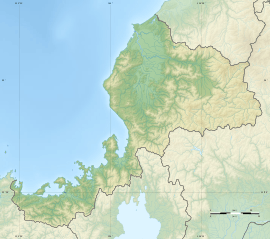Matsuoka Kofun Cluster
Matsuoka Kofun Cluster (松岡古墳群, Matsuoka Kofun-gun) is a group kofun burial mounds located in what is now part of the town of Eiheiji, Fukui in the Hokuriku region of Japan. The site was designated a National Historic Site of Japan in 1977 in the case of the largest of the group. Protection was extended to the remainder of the group in July 2005.[1]
松岡古墳群 | |
 Tegurigajoyama Kofun | |
 Matsuoka Kofun  Matsuoka Kofun Cluster (Japan) | |
| Location | Eiheiji, Fukui, Japan |
|---|---|
| Region | Hokuriku region |
| Coordinates | 36°05′35″N 136°18′53.2″E |
| Type | kofun |
| History | |
| Founded | late 4th or early 5th century AD |
| Periods | Kofun |
| Site notes | |
| Ownership | National Historic Site |
| Public access | Yes |
Overview
The kofun group is located on a hillside overlooking the Kuzuryū River and consists of four large keyhole-shape tumuli. The tombs are estimated to date from the mid 4th to the late 5th century AD. The tombs do not appear in any historical records and the name of rank of the persons buried within are unknown, although per local legend, these were the graves of the "Kings of Koshi" (越の国), the pre-Yamato dynasty state which controlled present-day Fukui, Ishikawa, Toyama and Niigata Prefectures.
The kofun
Tegurigajoyama Kofun (手繰ヶ城山古墳) is the largest of the four, with a total length of 127 meters, making it is the second largest found in the Hokuriku region of Japan after the Rokuroseiyama Kofun. The circular portion is 80 meters in diameter and 18 meters high; the rectangular portion is in two tiers, with a height of 10 meters. Large numbers of fukiishi and cylindrical haniwa were found in the area. The details of the interior are unknown as the kofun has not been excavated; however, ground-penetrating radar has confirmed that a stone sarcophagus exists. The kofun was dated to the middle of the fourth century.
Torigoeyama Kofun (鳥越山古墳) is the smallest of the four, with a total length of 53.7 meters; however, it was found to have a boat-shaped stone sarcophagus and two passage graves. A large number of grave goods were also uncovered, including stone spearheads, whetstones, fragments of iron implements, earthenware and horse fittings. It was dated to the middle of the fifth century.
Ishifuneyama Kofun (石舟山古墳) has a length of 79.1 meters and also dates from the middle of the fifth century. It was robbed at some unknown time, and fragments of a boat-shaped stone sarcophagus were exposed, thus leading to its name.
Nihonmatsuyama Kofun (二本松山古墳) has a length of 89 meters. It was extensively excavated in the Meiji period and numerous grave goods were recovered, including bronze mirrors, fragments of a crown, cylindrical beads, swords and other fragments of weapons. It was dated to the late fifth century.
References
- "六呂瀬山古墳群" [Matsuoka kofun gun] (in Japanese). Agency for Cultural Affairs.
External links
| Wikimedia Commons has media related to Matsuoka Kofun. |
- Fukui Prefectural home page (in Japanese)